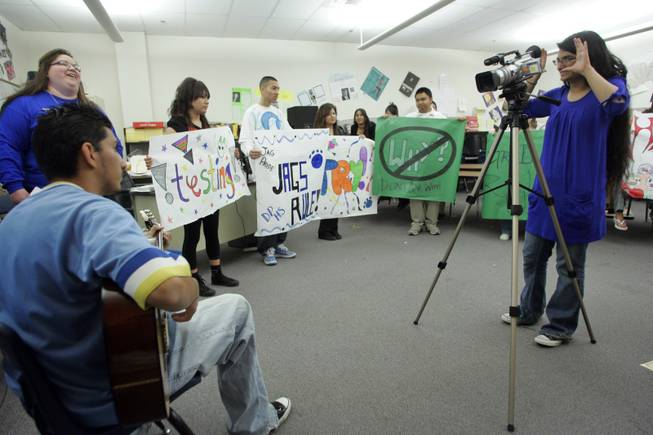
Jess Malik prepares to video students in Jayme Rawson’s journalism class at Desert Pines High as they make a proficiency test “fight song” video Wednesday.
Friday, March 28, 2008 | 2 a.m.
Audio Clip
- Select students at Desert Pines High School put together rap-like lyrics and a base-induced beat to get students to attend proficiency testing.
-
Audio Clip
- Desert Pines High School students persuade the student body to take proficiency tests with creative lyrics and an acoustic melody.
-
Next week’s Nevada High School Proficiency Exam should help determine just how big Clark County schools’ math problem is, but the test is also part of the problem.
It’s an all-important test for several reasons, including that it is used to calculate each school’s “adequate yearly progress” under the federal No Child Left Behind Act.
In the days and weeks leading up to the spring exam, schools provide extra tutoring, offer weekend cram sessions and stage pep rallies. Principals raise money to offer everything from iPods to cash to ensure students show up because schools are penalized if at least 95 percent of eligible students do not take the April test.
Behind the flurry of activity, however, a bigger worry is looming for the Clark County School District. In two years’ time, the math section of the proficiency exam — already an Achilles’ heel for many students — will be revamped, and the level of difficulty will dramatically increase.
Despite the fact that passing the statewide math proficiency test is a high school graduation requirement, about 40 percent of the test is based on fundamental math skills that students are supposed to have acquired by eighth grade. The U.S. Department of Education has told Nevada it must revise the exam so that only high school-level material is included.
While the district worries about pending federal demands, results of its own new math test for high schoolers suggest the district’s students are woefully unprepared for the higher expectations ahead.
Because Superintendent Walt Rulffes is eager to reduce the percentage of students who are sent to remedial classes when they arrive at Nevada colleges and universities, and because the district’s graduation requirements were revised last year to add a fourth year of math, the district created an end-of-semester test to measure how well high school math students were mastering the subject matter.
The results were troubling.
More than 90 percent of Algebra 1 students and 87 percent of Algebra 2 students failed the test. And 88 percent of geometry students also failed.
The high school proficiency exam and the end-of-semester test measure different things, and the results are not directly comparable. The district has seen steady improvement in its math proficiency test pass rate, particularly among students taking it for the first time. But some educators believe passing the lower bar of the state exam has become the priority, at the expense of students’ learning all of the required material.
To be sure, the district’s challenges are plentiful — a shortage of math teachers, overcrowded classrooms and a transient student population. But Rulffes said he is not looking for excuses.
“We have to face up to our weaknesses,” Rulffes said. “It may be that we are falling short meeting our curriculum requirements in elementary or middle school. This is an opportunity to address those issues and improve.”
The district believes there may be some serious kinks in its new test. Teachers have complained there were too many questions for students to realistically answer in the hour allotted, and there may have been discrepancies among campuses in how the test was administered.
To help teachers prepare their students for the end-of-semester test, the district distributed instructional guides and practice questions to be used along the way, said Lauren Kohut-Rost, the district’s deputy superintendent of instruction. It was unknown Thursday how many teachers put those guides to full use.
The next step for the district, said Kohut-Rost, is to review the test’s content, check for weaknesses in how it was administered and make the necessary corrections.
“There were some legitimate concerns raised,” Kohut-Rost said. “We fully expect to see improved results in the second semester.”
Bill Hanlon, director of the Southern Nevada Regional Professional Development Center, helped the district design the new test. He said he believes that because so many students arrive at high school unprepared for the academic rigors, teachers were forgoing the expected curriculum for fundamental lessons that should have been covered in earlier years.
Hanlon said in prior years he’s come across teachers who made the individual choice to alter their curriculum to help students get up to speed in math. But this time, Hanlon said, at some schools the decision was apparently being made as a group by the entire math department, with the approval of campus administrators.
“That’s not something I’ve seen before,” Hanlon told the Clark County School Board at Thursday’s meeting.
“They were taking the entire first nine weeks and doing basic math facts so that kids could pass the proficiency test,” Hanlon said. “That was a bad decision made in good faith.”
What needs to happen, Hanlon said, is for students to be taught the expected material in elementary school before advancing to middle school, and for the same thing to happen before they move on to high school.
“If everyone does the job they are hired to do, we would be in much better shape,” Hanlon said. “When the 10th grader can’t do his work because he didn’t learn what he needed to know by seventh grade and way back in fourth grade, that’s a system designed to fail. And that’s just what happened here.”


Join the Discussion:
Check this out for a full explanation of our conversion to the LiveFyre commenting system and instructions on how to sign up for an account.
Full comments policy